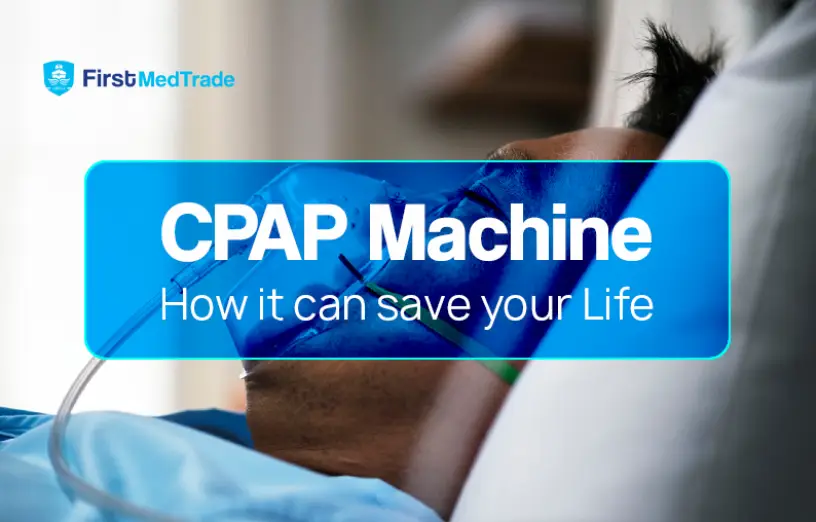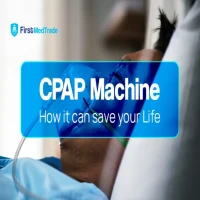CPAP MACHINE - HOW CAN IT SAVE YOUR LIFE?
If you're overweight, feel a sudden shortness of breath while sleeping, if your snoring is discomforting, and if you notice daily unrefreshing sleep, You need a CPAP!
What is a CPAP machine? By what means does a CPAP machine work? Why might you need a CPAP machine? What factors should you consider when getting a CPAP machine? What are the benefits of CPAP? What are the side effects of using a CPAP? This article provides a walkthrough.
What Is A CPAP Device?
CPAP is the shortened form for continuous positive airway pressure. It is a machine that is used to keep your airways open by gently providing air through a mask you wear while you sleep so you can receive the oxygen you need for optimal function. It is also known as CPAP therapy.
It splints the airway open and eliminates the breathing pauses caused by sleep apnea—a potentially serious sleep disorder in which breathing repeatedly stops and starts, thereby cutting off oxygen in the body. Poor sleep quality can lead to many other long-term health risks, such as diabetes (type 2), depression, heart disease, high blood pressure, and more.
CPAP machine is also used to treat underdeveloped lungs in preterm infants.
What Does A CPAP Machine Look Like?
A CPAP system is a small air compressor with a flexible hose or tube and a mask. Most CPAP machines may equal the size of a tissue box. They are usually lightweight and relatively quiet. The CPAP machine can be placed on your nightstand or at the side of your bed.
CPAP Machine with tube and nasal mask
The tube connects the CPAP machine to the mask. The tube is long enough for you to move around or roll over in bed.
A CPAP mask can only cover your nose or both your nose and mouth. Another option is to use a nasal pillow, which fits over your nostrils. Some other masks fit snugly under your nose. Whatever mask you use, it's important that it fits and is comfortable. The mask must make a seal for your airway to be kept open through the night. A good mask seal will prevent air leaks and maintain the correct air pressure level.
Types of PAP Therapy
There are two main types of PAP therapy. All forms of PAP therapy keep the airways open during sleep by providing airflow through a mask that you wear.
APAP
Autotitrating positive airway pressure (APAP) therapy automatically pushes pressure out at a particular setting by raising or lowering your air pressure as needed during the night.
BPAP
The Bilevel Positive Airway Pressure (BPAP) device has two alternating pressure levels. There is a certain pressure when you inhale that drops when you exhale, which is determined either from an in-the-lab or in-home titration.
All PAP therapy machines have a ramp feature that takes your pressure down and slowly builds it up again. This allows for time to fall asleep while the pressure
is still low.
If you have problems using CPAP or APAP, your sleep doctor may recommend BPAP. Your doctor may also endorse BPAP if you have sleep apnea along with
another breathing disorder.
Types of CPAP Masks
CPAP machines are designed with different masks, depending on your unique needs.
- Nasal Pillow Mask: is even more lightweight and minimal than nasal masks, offering a high level of openness and visibility. This mask uses flexible silicone
tubes that fit snugly over your nose. This can be helpful if you have air leaks or don't like the feel of the mask on your nose and face.
- Nasal Mask: fit over your nose only, offering a tighter fit than full face masks. This is the most common type of CPAP mask.
- Full face mask: This mask may cover your nose and your mouth or may sit under your nose and cover your mouth. This type of mask can be useful if you have an air leak when using a nasal mask.
Humidifier
A CPAP humidifier can help reduce the side effects of treatment and make it easier to breathe through a mask. Some people may experience irritation of the
nose or nasal discharge from using CPAP. Humidifiers can reduce these side effects by providing cool or hot moisture to the air from the CPAP device.
Many CPAP devices have a built-in humidifier.
How does the CPAP machine work?
The CPAP machine takes in ambient air, then filters it and pressurizes it before delivering it through a tube and into the mask. The gentle continuous airflow
prevents the tongue, uvula, and soft palate from moving too far into the airway. This stabilizes your breathing and improves the overall quality of your sleep.
Why might you need a CPAP machine?
When you use a CPAP machine during sleep, you will no longer snore or make choking noises in your sleep. You will be able to sleep all through the night without your body waking up due to a lack of oxygen. This will significantly improve your sleep quality which, for some people, means you will feel more rested and alert during the daytime. Your memory and mood may also improve.
Also, note that having sleep apnea doesn’t necessarily mean you need to use a CPAP machine. While a CPAP is recommended for moderate and severe cases of sleep apnea, it can be helpful for mild cases as well. If you think you might have sleep apnea, see your doctor.
What factors should you consider when getting a CPAP machine?
Your CPAP mask selection is the most important aspect of ensuring the success of your CPAP therapy. Choosing a comfortable CPAP mask can help you use
your treatments regularly and enjoy a comfortable night.
If you don't feel comfortable with your CPAP mask, you'll tend to "forget" to put it on some nights or take it off at midnight because it doesn't feel right, not even
realizing you've been doing this until you wake up the next morning!
Four (4) things to consider before choosing your CPAP mask
1) When choosing a CPAP mask, consider your face shape
2) Consider your facial hair
3) Consider whether you’re claustrophobic at all.
4) Your favorite sleeping position
How to choose the right CPAP
Ultimately, the best type of CPAP machine depends on your sleep disorder and doctor’s prescription but there are a few other factors to consider such as:
Noise: Although most devices are designed to avoid excessive noise, some devices work better than others. This factor may be especially important for light
sleepers or if the patient shares a room with others.
Portability: If you're relying on a CPAP machine for a good night's sleep, it's important to remember that wherever you go, your CPAP machine will need to go
with you. So consider how often you will have to move and the size/weight of any CPAP machine you buy.
Humidifier & Heating Installments: CPAP devices often include a humidifier and heat settings to prevent the patient from breathing in dry air throughout the
night. CPAP machines with adjustable humidifiers and heat settings are popular because they allow patients to adjust the humidity and air temperature to the
level they are most comfortable with.
What are the benefits of CPAP?
CPAP can prevent or reverse the serious consequences of sleep apnea. Treating sleep apnea can help protect you from serious health risks. Using CPAP to treat sleep apnea can also improve many aspects of your life. Benefits include:
- Heart disease prevention
- Stroke prevention
- Diabetes prevention
- Vehicle accident prevention
- Improved daytime alertness
- Improved concentration
- Improved emotional stability
- Elimination of snoring
- Lower medical expenses
What Are The Common Side Effects Of CPAP Mask And What Can You Do?
CPAP mask has few side effects. Most of these problems can be fixed through simple adjustments.
Strap marks or skin sores: These occur as a result of poor mask fit and are eliminated by adjusting or changing the type of mask. Ensure your mask strap is not too tight. It can also help if you purchase soft CPAP strap covers to reduce the friction of the belt against your skin.
Dry nose and sore throat: A humidifier attached to your CPAP device relieves dry nose and sore throat by providing air-cooled or heated moisture. Sometimes it
is necessary to change the mask style to avoid dry nose, mouth, or sore throat. So you have no worries.
Nasal congestion, runny nose, and sneezing: Using a saline nasal spray can relieve mild nasal congestion. Increasing the humidity of your device can be helpful. Talk to your doctor about medicine for a stuffy nose, runny nose, or sneezing if it affects your ability to use the CPAP machine.
Tips for using a CPAP machine
For some people, using the CPAP machine in the early stages can be very challenging. It may take some time for you to get used to CPAP therapy. Follow these
tips to improve the quality of your sleep with CPAP:
1.) Start using your CPAP during short periods of the day when you watch TV or read. This will help you get used to wearing your mask.
2.) Make the use of CPAP a part of your bedtime habit. Use CPAP every night and for every nap.
3.) Make a few adjustments to increase your comfort level. Adjust the straps on your mask and headgear until it fits right. You can also try using a special
sleeping pillow designed for CPAP masks and tubes.
4.) Make sure your mask fits properly. If the mask is too large, the straps that hug your face will need to be tightened. It can irritate your skin or cause sores
when the straps rub against your face. You can purchase a soft CPAP strap to reduce the friction of the strap against your skin. Masks that are too small will not seal tightly and air will escape around the edges. Air can blow into your eyes. If you have either of these problems, you may need a different mask or
headgear.
5.) If the pressure seems too high as you are trying to fall asleep, use the “ramp” mode on your CPAP unit. The ramp mode will start your device on a
low-pressure setting and gradually increase the pressure over time. You should be able to fall asleep before the air pressure reaches its set level.
6.) Use a saline nasal spray to relieve mild nasal congestion.
7.) Use a humidifier if you have a dry mouth, throat, or nose.
8.) Schedule periodic cleaning of your device. Clean your mask, tube, and headgear weekly. Put that hour on your schedule so you don't forget to do it.
9.) If you have trouble remembering to use CPAP every night, find someone to help you. Consider joining a support group or having someone you trust hold you
accountable for your CPAP use.
If these adjustments don't work, or if you need more advice or help, talk to your sleep center staff or doctor.
They are prepared to help you adjust your CPAP. This may be at your doctor’s office or at your durable medical equipment office where you pick up your PAP
machine, mask, and supplies for PAP.







